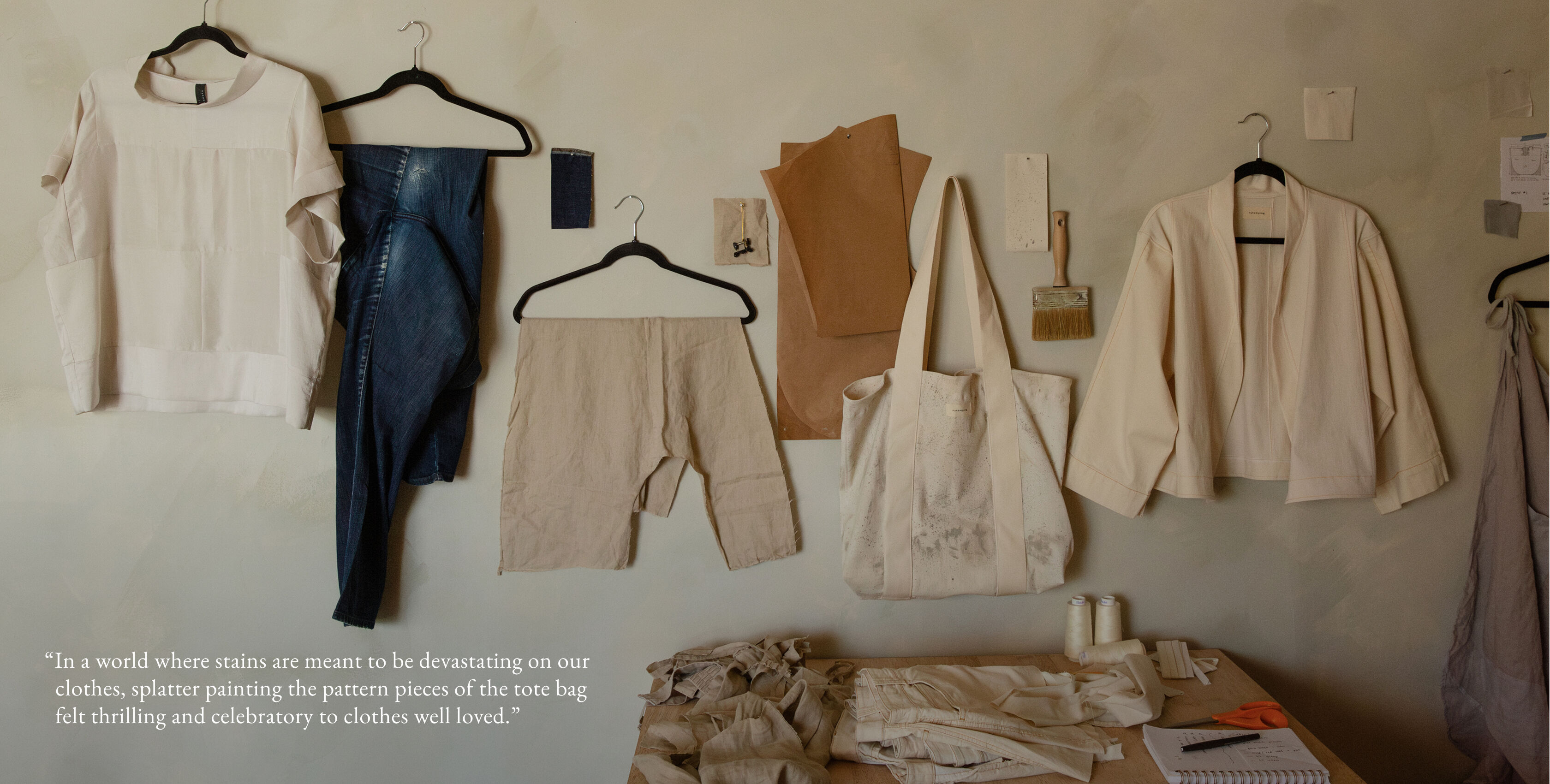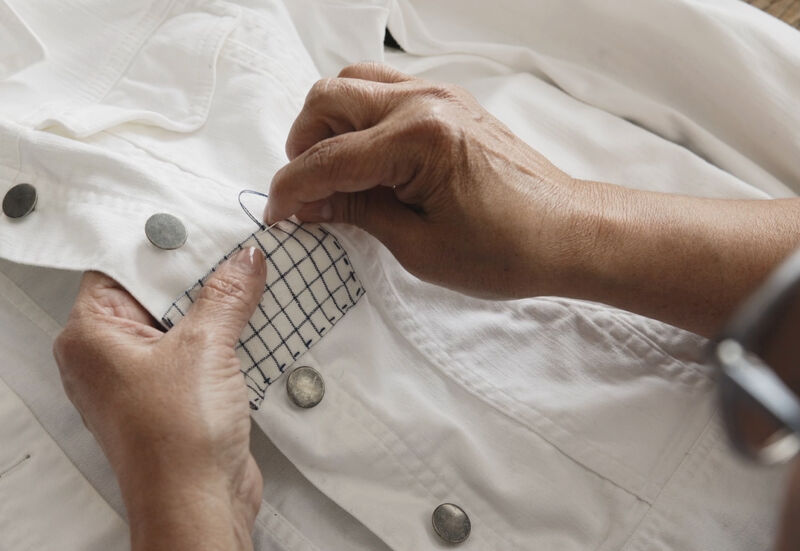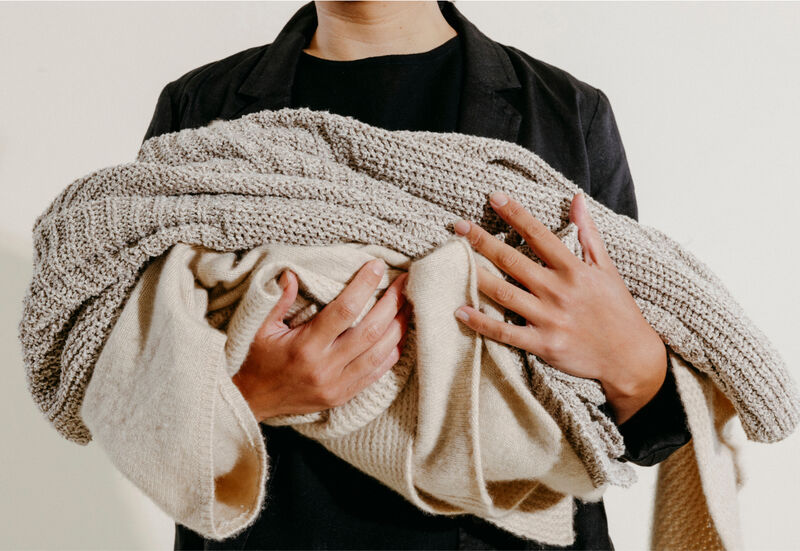The Art of Upcycling: Elijah Nykamp
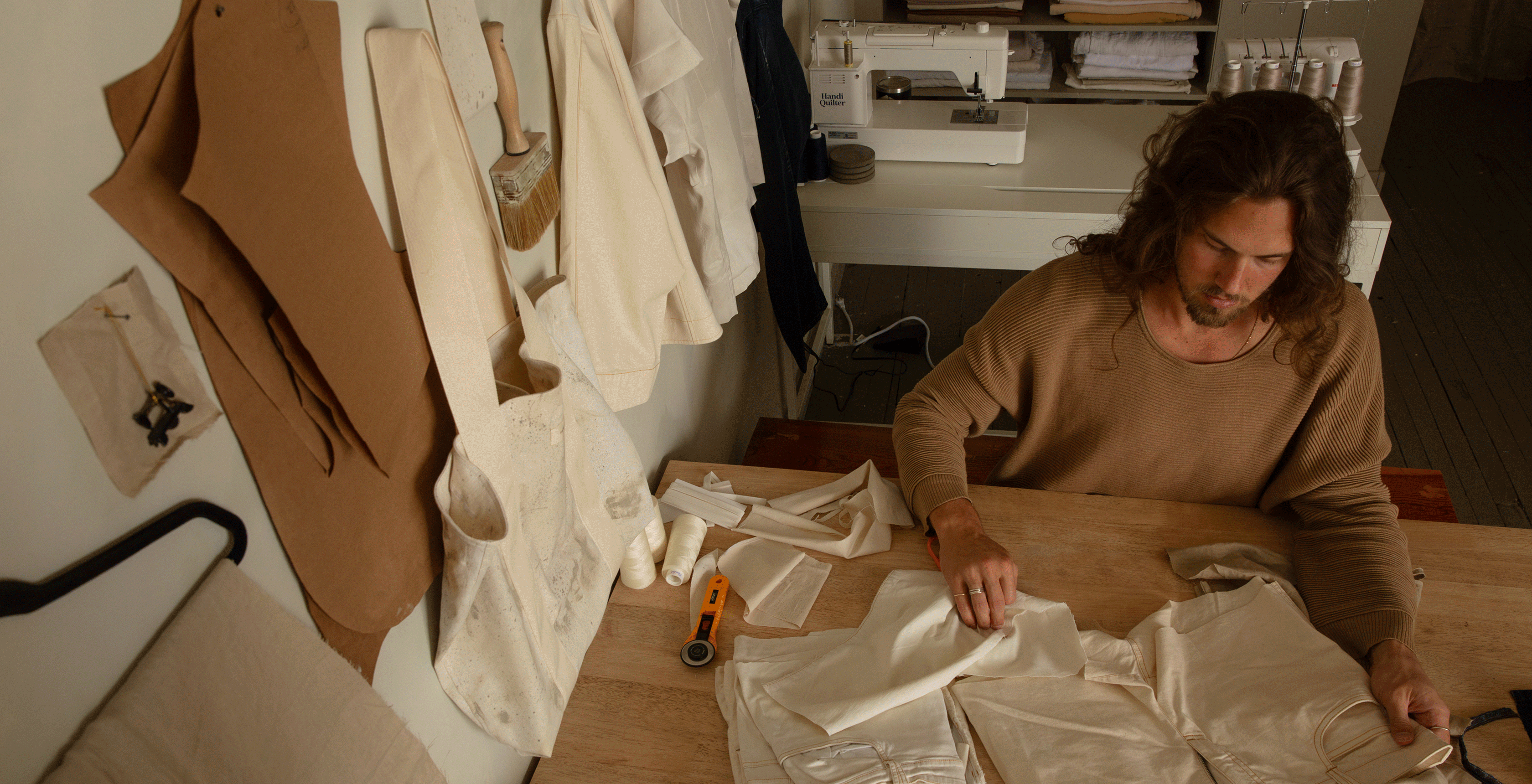
One person’s textile waste is an upcycling artist’s treasure. Meet Elijah Nykamp—solo designer, sewist and owner of nykamping—and learn how he transformed Renew pieces into one-of-a-kind designs.
Nestled in Suttons Bay, Michigan, a small beach town on Leelanau Peninsula, nykamping sparks curiosity among locals and tourists alike passing by the storefront sign’s unique callouts: “local,” “zero waste,” “ethical,” “wearable art” and “sustainable.” Stepping inside, those values come to life in Elijah’s upcycled pieces, from quilted tote bags to his trademark coats thoughtfully displayed on racks and limewashed walls. Elijah intends each garment’s oversized silhouette to serve as “a tent for your body,” designed with size inclusivity and gender neutrality in mind. For each collection, he revitalizes a wide spectrum of locally sourced secondhand textiles—including a shower curtain turned patchwork jacket—thanks to some diligent TLC and a lot of imagination.
This spring we asked Elijah if he’d be interested in upcycling pre-loved EILEEN FISHER pieces into two new looks. He embraced the challenge, requesting “the worst of the worst”—the most damaged and stained pieces collected through our Renew take-back program. After Elijah toured the Renew warehouse, our team sent him a shipment of our well-worn garments to be reincarnated into nykamping designs. We visited his hybrid studio and showroom store on a gloomy summer morning to discuss all things upcycling and his creative process—from deconstruction to artful reconstruction.
Photos by Lindsey Mak
Answers have been lightly edited for length and clarity.
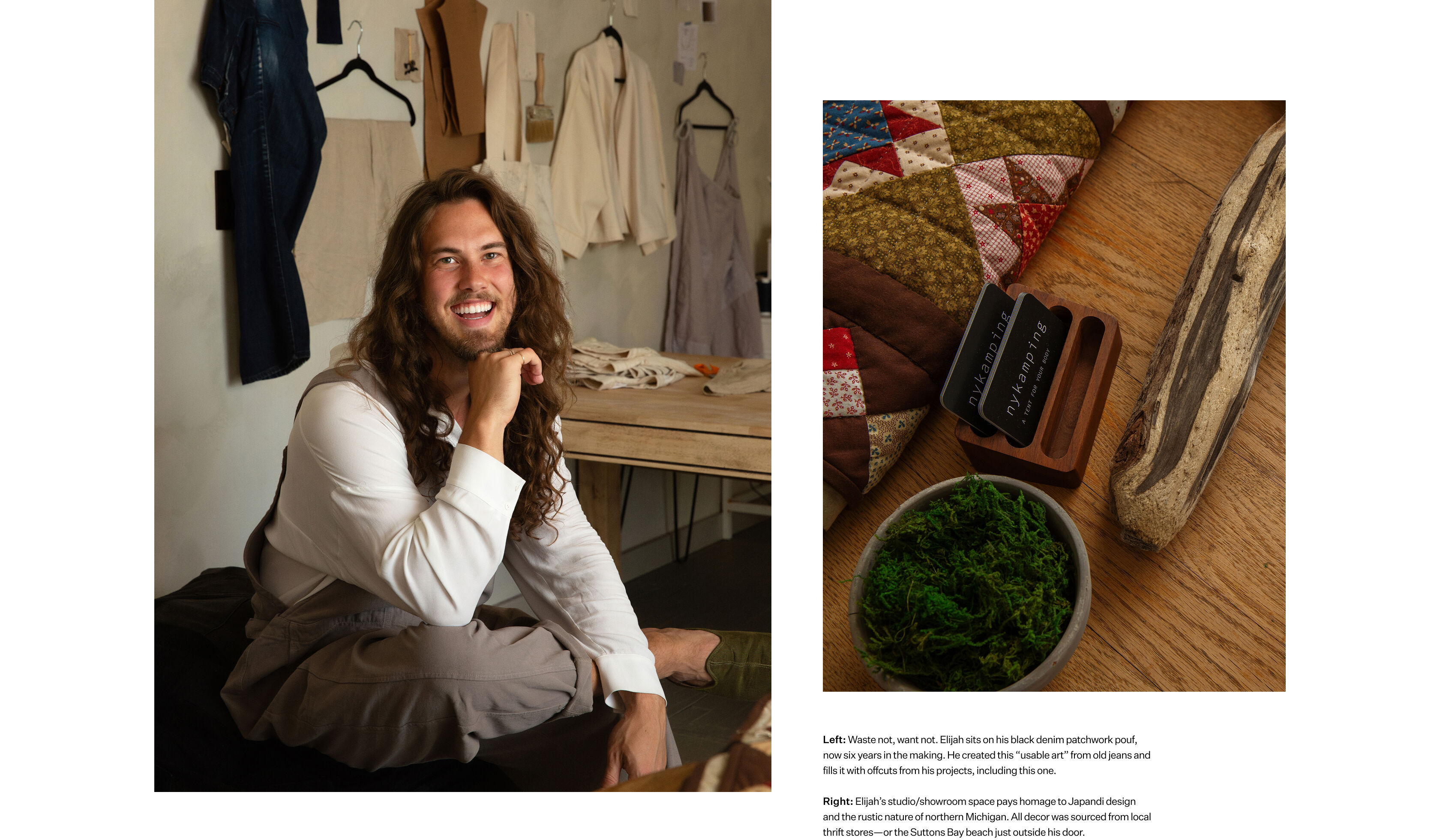
How did you get into upcycling? When did it become a passion?
Elijah: I feel like my love for thrifting has evolved into a passion for upcycling. My mom and I have been thrifting together since I was young. At first, it didn’t feel so purposeful at a young age; we just enjoyed the treasure hunt. Then as I got older, it started to click that this is also better for the world. I’d find some incredible textiles and wonder what I could do with them.
When I was starting to sew, the cost of materials was really shocking. So, when I found a linen duvet cover that has yards and yards of material in it, I realized, wow, that’s a great way to source materials at a lower cost. And this softened, beautiful linen, in my opinion, can sometimes be even better on your skin than a brand new, really crisp, off-the-bolt linen. So that was the beginning—finding some of those materials in a completely different form, like linen tablecloths that have this silhouette built into them for a jacket or top.
How did you learn to sew?
Elijah: My mom taught me how to use a sewing machine when I was eight. I held on to those skills for a long time but didn’t use them. Then during COVID, I bought a sewing machine from a thrift store and ended up using a lot of this newfound time to relearn how to sew and fell in love. I’d watch video tutorials on YouTube and Pinterest to learn how to do certain seams and sewing techniques. The pandemic completely changed the trajectory of my life and my occupation. I’ve just loved working with simple, modern, boxy silhouettes and really letting the textiles shine.
What was the first piece you made?
Elijah: I actually wore it today and during my Renew warehouse visit in New York. It’s a patchwork coat that includes fabric from baby clothes my mom made and other remnants of textiles from my life. The band of the collar is from a material that I got at a market when I was working in Nigeria as a kindergarten teacher. Tailors are very common and important to Nigerian culture. I got to know a few of them and based what I was having them make for me off the cotton poplin robe styles that many older Nigerian gentlemen wear. Those styles inspired the clothing that I make now: breezy, falls off the shoulders and doesn’t cling anywhere else.
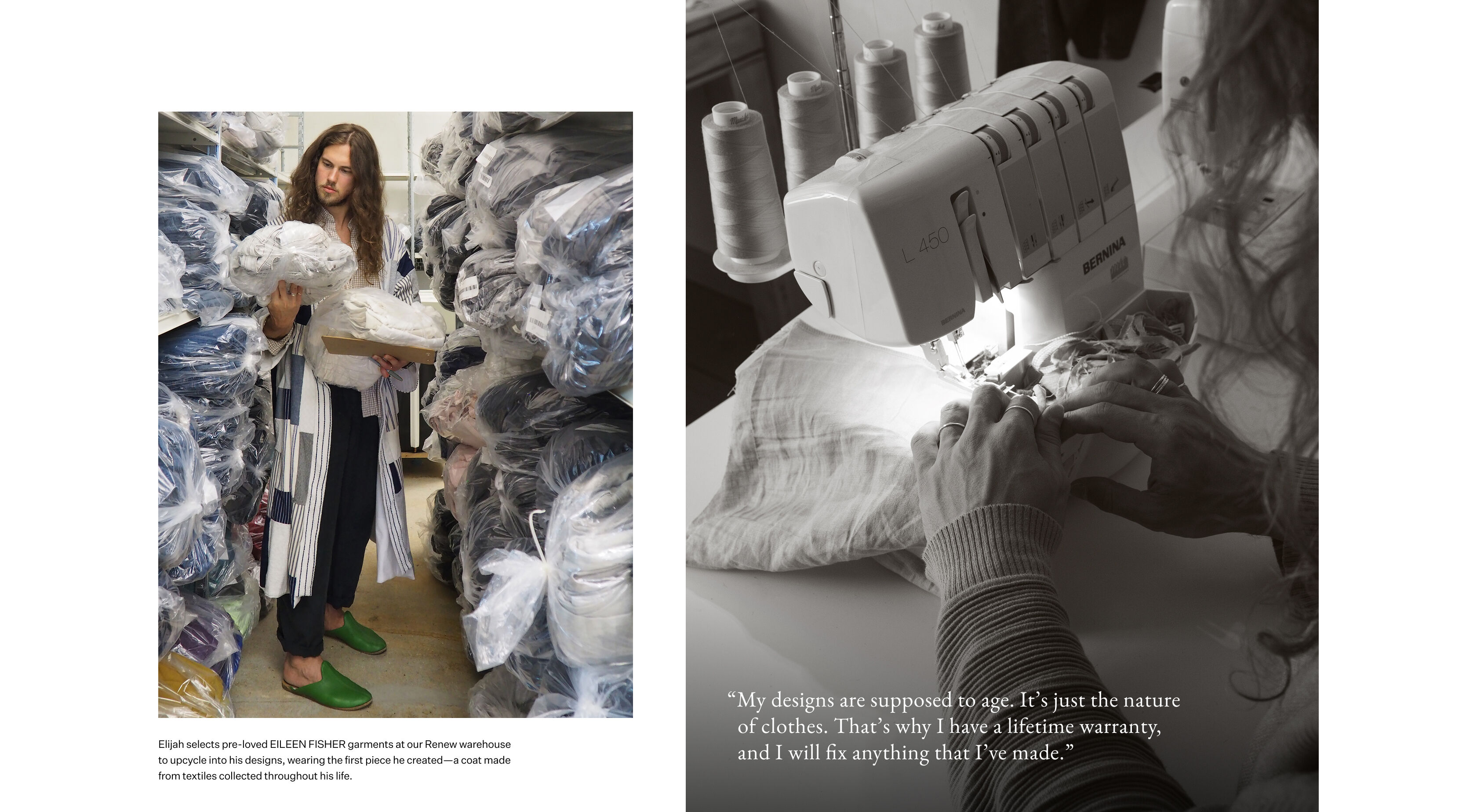
What role has community engagement played in supporting your slow fashion mission?
Elijah: The Suttons Bay community has supported nykamping with such excitement that people show up with old quilts, blankets and tablecloths, thrilled to let me look through their stash before their trip to the thrift store. My community needed no encouragement; they’ve been supportive since the beginning. They feel involved and a part of something more certain than dropping off items to Goodwill, because they know their discarded textiles will become beautiful, unique clothing that someone will truly love.
You call your designs “wearable art,” which inspires an appreciation for craftsmanship and treasuring pieces made to last. What are some other ways you think we as consumers can reframe our relationship with clothes?
Elijah: One of the conversations I’ve had with customers is if you find one piece that you really connect with and are ready to invest in, think about the price per wear. If you prioritize quality over quantity, chances are you’ll actually love every single piece in your closet, rather than spending a lot of money on pieces you won’t touch.
With nykamping, I’m also trying to show that imperfections and irregularities are beautiful. The pieces in last summer’s collection have a lot of clouding and variability from botanical dyes that make each piece one of a kind. I also emphasize that my designs are meant to be worn and loved and washed, and they’re supposed to age. It’s just the nature of clothes. That’s why I have a lifetime warranty, and I will fix anything that I've made.
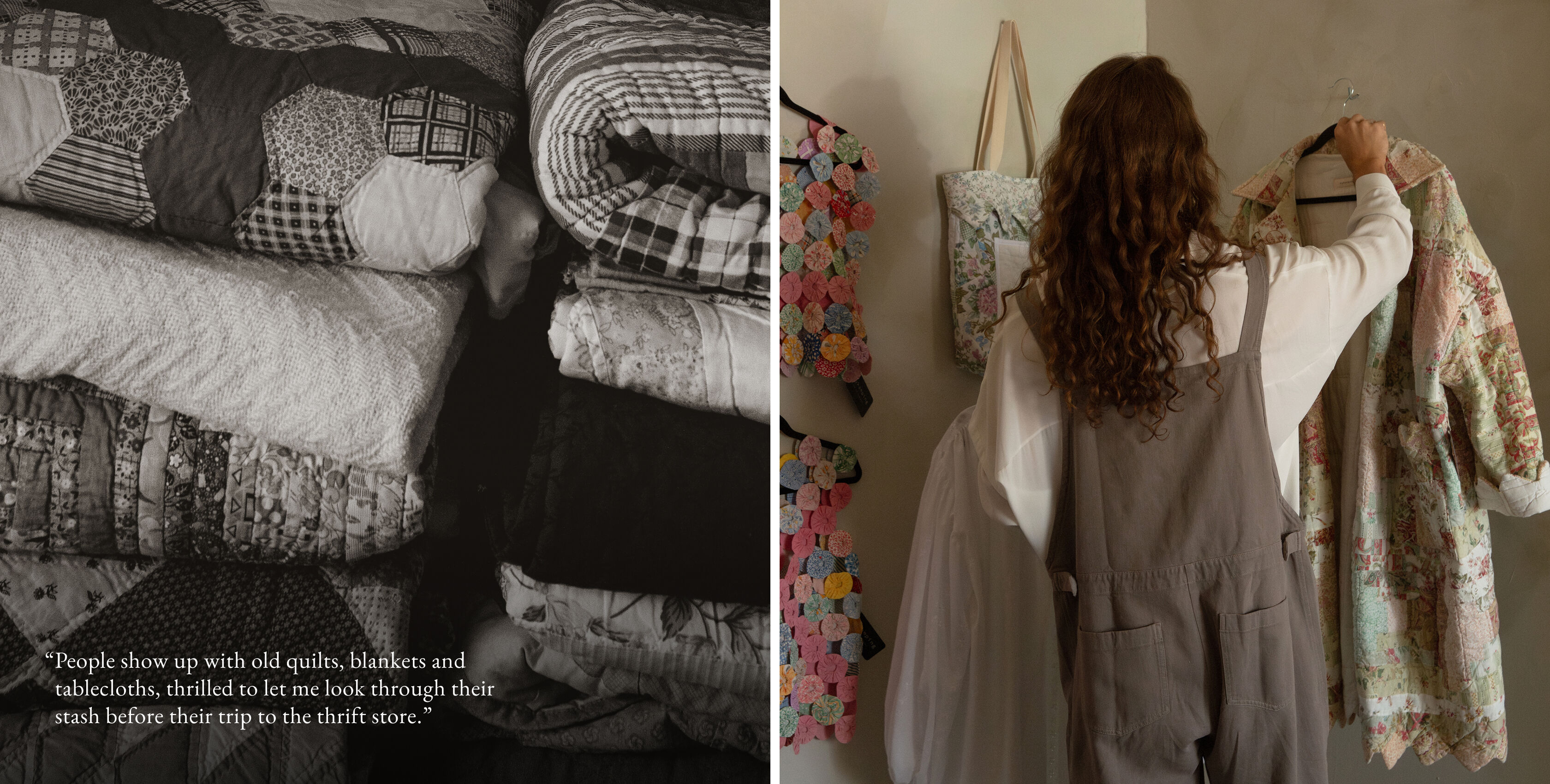
What was your experience touring the Renew warehouse in New York? Did anything surprise you behind the scenes?
Elijah: I was blown away by the organization of it all—intaking so many pieces and sorting them by color and material. The fact that all of them then get washed is huge because I do a lot of washing at the laundromat before creating pieces and it takes up a lot of time. EILEEN FISHER clothes are made to last, and people recognize that they're worth sending back. They know that with Renew, the pieces are headed either to a new home, downcycling, fiber-to-fiber recycling or to small creators like me. Seeing how it’s a small operation felt very inspiring as a one-person team. I know that you can do a lot in a day, and it just felt really encouraging to see how the small-but-mighty core team at Renew does it all.
Once you received the Renew garments, how did you approach the design process for these pieces?
Elijah: First, I organized pieces by color and material—mostly silk, linen and denim. Next, I assessed each piece for damage, stains and distressing so I knew where to cut around. Then I deconstructed the garment back into its two-dimensional form and assessed any different elements that I might want to keep, like the pockets from a pair of pants I took apart and used for the linen wrap pants. I did a bunch of ironing just to make sure they were all flat and ready for slicing on the rotary cutter. The next stage was patchworking and laying out pattern pieces.
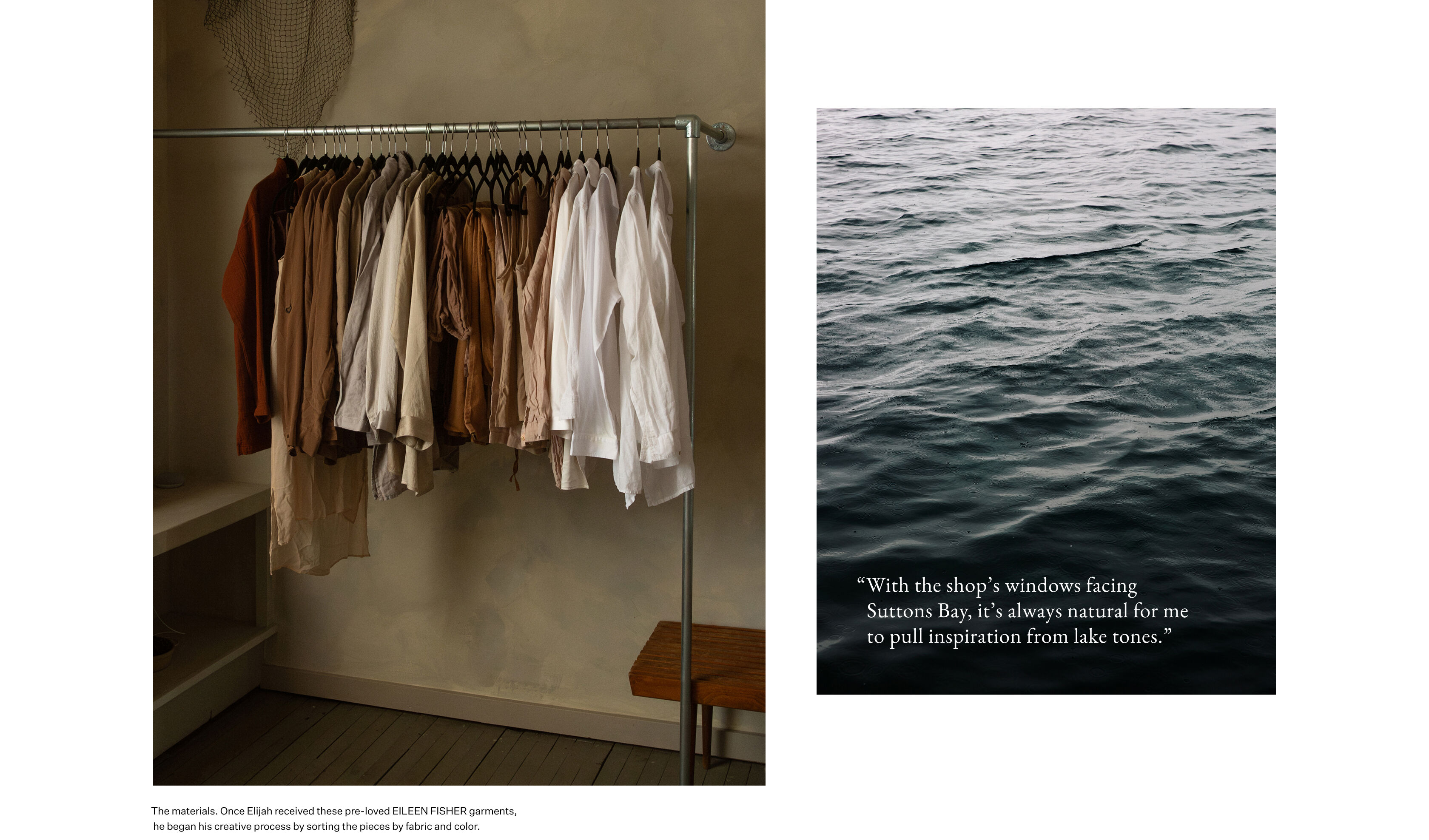
What was your vision for the two outfits you created?
Elijah: With the shop's windows facing Suttons Bay, it’s always natural for me to pull inspiration from lake tones. The color palette for both outfits was inspired by the scenes right outside my door on a hazy morning. The first outfit includes a subway tile mock neck top patchworked from multiple pairs of matching ivory silk pants and a blue patchwork stretch denim jacket. I also made a Japanese gardening-style pant from light gray linen pants. It has a wrap design, which has ties so it's size inclusive. The whole look feels very nautical but more in a foggy, subdued way than a preppy one.
The other outfit pairs an off-white stretch denim jacket patchworked in vertical strips with a beige bubble dress made from four pairs of linen pants. Imagine that line along the shore where the frothy waves climb up the hard-packed sand. With the extra off-white denim material from the jeans, I made a tote with beige splatter paint to tie the outfit all together and add unique visual interest. In a world where stains are meant to be devastating on our clothes, splatter painting the pattern pieces felt thrilling and celebratory to clothes well loved.
A fun challenge with these outfits was designing with size inclusivity in mind. As a foundational element of nykamping, the goal was for each one of those pieces to work on someone who typically wears a size S up to a size XL. With roomy armholes and wide, modern sleeves, the intention is for a timeless, breezy, relaxed look. Personally, I love sizing up and playing around with proportions as I style my clothing. My work's focus isn't to make clothes that are innately flattering. These outfits are comfortable and neutral, welcoming influence from Japandi stay-at-home style.
Having recently celebrated two years of nykamping, what are some of the key takeaways you’ve learned from turning your passion for upcycling into a business?
Elijah: I’ve realized that the element of upcycling that I love also happens to be the one that makes it an inefficient business. Constantly problem solving and pattern making from every piece is simultaneously thrilling and strenuous. I’ve had to find ways to replicate parts of the upcycling process to keep the business less time-consuming. Balancing creativity with production fuels the artist and business owner in me—both are equally important.
The world of upcycling and fashion is so overwhelming and broad. As one person with only so much time, honing my niche of oversized outerwear has helped me stay focused without feeling limited. Lastly, learning and implementing quality sewing techniques helped me take upcycling from a hobby to a business. My goal is to keep a level of craftsmanship and garment construction excellence regardless of the material. People take notice and recognize high quality work performed with a positive mission. It’s no longer crafty or DIY, it’s a smart and sustainable business model.
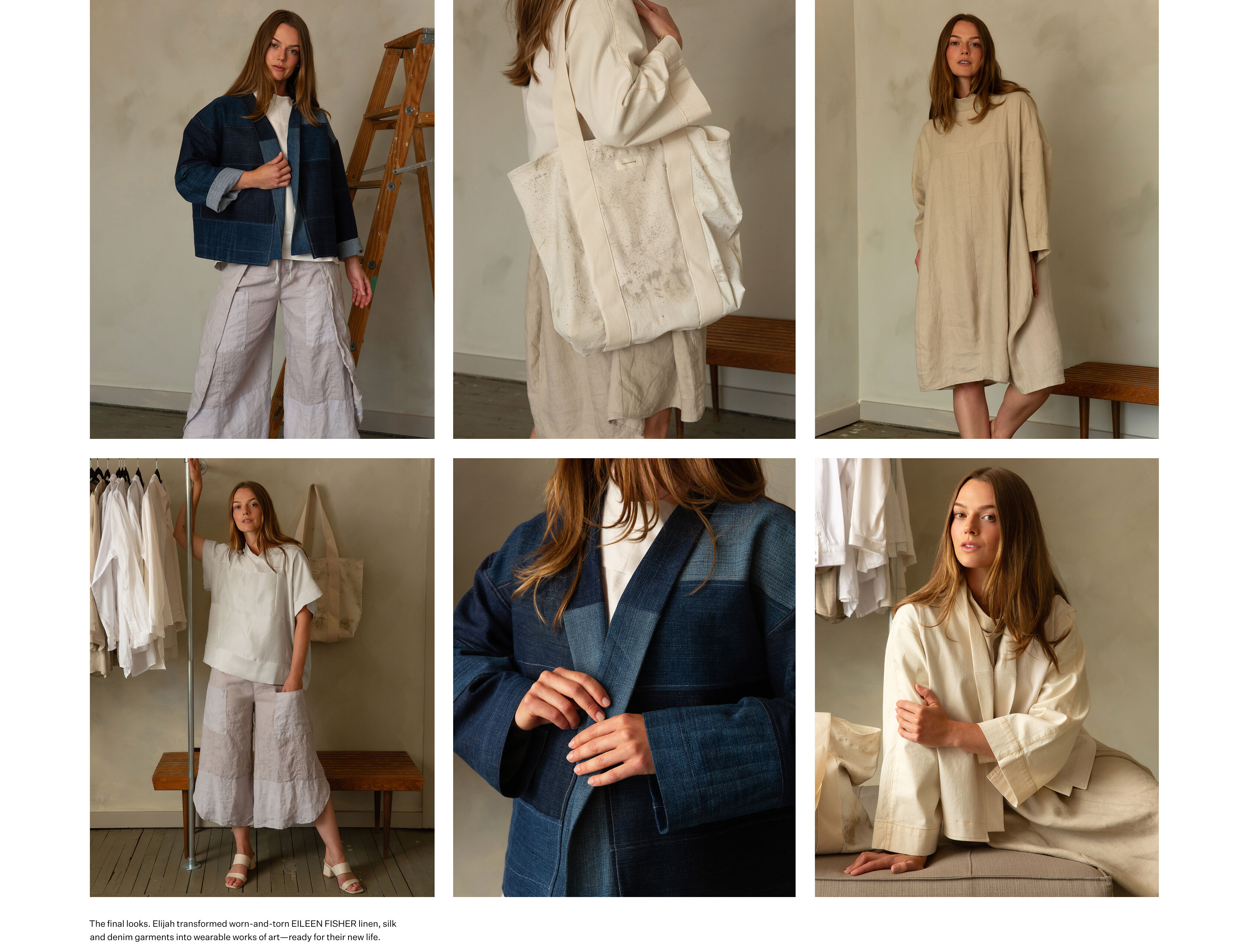
What does the art of upcycling mean to you?
Elijah: I think a lot of art is coming up with beautiful ways to problem solve. Upcycling textiles comes with significant challenges, such as dealing with holes and stains. You’re not using this abundance of possibility that you get from a bolt of fabric, instead you're creating beauty out of what was well loved and became “unusable.”
Capturing memories through upcycling is also constantly going through my mind with everything that I touch. There were memories put into this jacket or into this quilt or these beautiful linen pieces that are worn to threads. Someone loved this and they wore it to graduation parties or to family gatherings. It feels like so many of these EILEEN FISHER pieces were truly well loved. Instead of throwing them away, they sent them back through Renew—and now they get to become a new memory for a new person and something really special. That feels like art all by itself.
